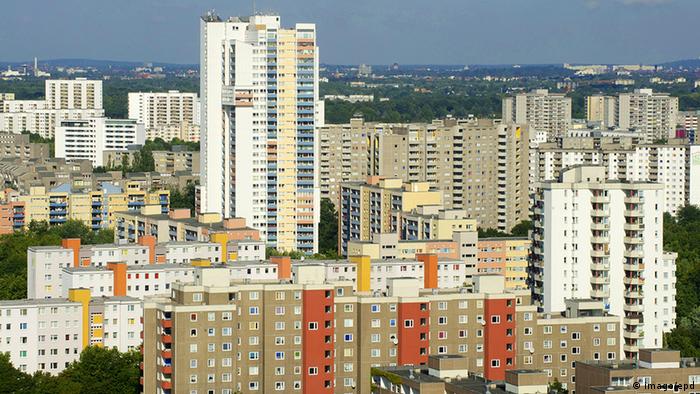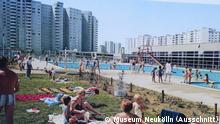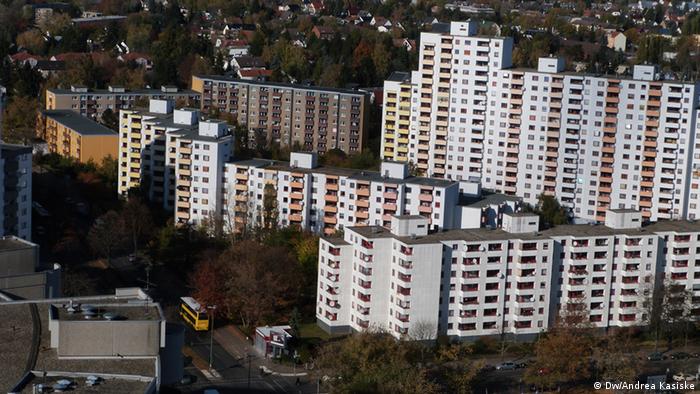
As architect Walter Gropius planned 50 years ago, the first major
settlement of Berlin was a kind of social utopia. Since then,
Gropiusstadt has been constantly changing.
Renate Ahnert, a Gropiusstadt resident said moving to the settlement
outside the center of the German capital was a great decision for her
for practical reasons, "Finally we didn't have to carry any more coal."
Central heating was the primary reason for Ahnert's move to the complex in 1965. The settlement was still totally under construction in 1962, after its foundations were laid. There was only one tram and a subway link was developed later. There weren't many open green spaces either.
"It was still a desert," said Ahnert, a teacher. "No kindergarten, nothing."
Urban living in the suburbs
When Bauhaus architect Walter Gropius was commissioned with the construction of the large residential complex called "Quartiers Britz -Buckow-Rudow" in 1958, he also created a sort of social utopia. Gropius created a dream of a better life in the suburbs in a housing complex away from the Neukölln dwellings with dark shared courtyards; outdoor toilets and coal stove fires. Gropius planned manageable living spaces in building with an average of four and a maximum of 17 floors, all of which would be intersected by a green corridor. In addition to good infrastructure, the complex contained shopping centers, cinemas, post offices and community centers ensuring the residents could still live an urban life.
 Walter Gropius created a social utopia for the residents of Gropiusstadt
Then the Berlin Wall was built in 1961, and the planned settlement ran
near the Wall. The plans were adjusted accordingly: the area of space
reduced in size, and the complex built higher. Some 14,500 apartments
were planned, yet 19,000 were eventually built, with building reaching
up to 30 storey-high housing more than 50,000 residents.By the time
construction was completed in 1975, Gropiusstadt - or the Gropius City -
as it came to be known, became a residential juggernaut.
Walter Gropius created a social utopia for the residents of Gropiusstadt
Then the Berlin Wall was built in 1961, and the planned settlement ran
near the Wall. The plans were adjusted accordingly: the area of space
reduced in size, and the complex built higher. Some 14,500 apartments
were planned, yet 19,000 were eventually built, with building reaching
up to 30 storey-high housing more than 50,000 residents.By the time
construction was completed in 1975, Gropiusstadt - or the Gropius City -
as it came to be known, became a residential juggernaut.
The stench of sewage
"'What, you live in Gropiusstadt?" was a comment Ingo Höse a teacher from Groupiusstadt said he faced a lot. "At that time, people saw it as menacing."
During the 70s, when Höse was much younger, the image painted of that part of Berlin was quite bad. Gropiusstadt was seen as a problem area associated with drugs and crime. Outsiders' perception, however, wasn't shared by Gropiusstadt residents.
The supposed juvenile delinquency was something Höse said he did not witness. Though he added that it was a difficult to reach "at the end of the world" and the stench of the sewage farm nearby would waft over. But he added the settlement had everything residents needed: a shopping center, friends, and his school. Berlin's first school in Berlin to have afternoon classes and left-leaning, engaging teachers - a model that has since spread across the capital - was located in Gropiusstadt.
Truly multicultural
 Gropius designed an urban complex away from the city
"I have 18 nationalities in my class," Cornelia Weis-Wilcke said with
a hint of pride. She's taught at the Walter Gropius high school for
many years. Today, it's especially multicultural in comparison to other
schools in Berlin.
Gropius designed an urban complex away from the city
"I have 18 nationalities in my class," Cornelia Weis-Wilcke said with
a hint of pride. She's taught at the Walter Gropius high school for
many years. Today, it's especially multicultural in comparison to other
schools in Berlin.
When the Berlin Wall came down in 1989, many of the first generation Gropiusstadt residents moved away. Most of the new inhabitants who moved there were migrants from Eastern Europe, Russia, Ukraine, Poland, and Turkish, Arabic and Asian migrants moved there too. The apartments were cheap and big enough for large families. Since 30 percent of the children living there are on social welfare, the schools and other social services offer free tutors for children, help with homework and try to provide parents with special assistance.
 With its 50th anniversary, Gropiusstadt will grow even bigger with further developments planned
While Gropius was planning Berlin's first major housing complex 50 years
ago, he was also designing unique cultural environment. Since then,
Gropiusstadt has been ever evolving. You don't talk about religion, you
talk about culture, said Julia Pankratyeva. The bright Ukrainian woman
is the heart of Gropiusstadt's cultural center. The engineer has worked
at the community center for the past 15 years. When she first arrived,
she immediately felt at home since the apartment buildings reminded her
of those in her native country, only "here it was so much greener," she
said.
With its 50th anniversary, Gropiusstadt will grow even bigger with further developments planned
While Gropius was planning Berlin's first major housing complex 50 years
ago, he was also designing unique cultural environment. Since then,
Gropiusstadt has been ever evolving. You don't talk about religion, you
talk about culture, said Julia Pankratyeva. The bright Ukrainian woman
is the heart of Gropiusstadt's cultural center. The engineer has worked
at the community center for the past 15 years. When she first arrived,
she immediately felt at home since the apartment buildings reminded her
of those in her native country, only "here it was so much greener," she
said.
Pankratyeva organizes music nights with singing and dancing mainly for the older inhabitants and children in the community. She said he makes it a point to bring together people who might otherwise not interact with each other. The center's Kurdish/Turkish/Greek night has been a total success, with the different music sparking interest in one another, she added.
A big anniversary
In the hall of shopping mall, a small exhibition is on display showcasing small portraits of Gropiusstadt residents of different ages and backgrounds. But one common thread exists among them: They all enjoy living in Gropiusstadt and are somewhat proud of it.
As part of the 50 year anniversary of Gropiusstadt, the complex is set to expand once again with 400 new apartments, as well as new shops and hotels that are to be built to more attract new residents to the complex. The legendary housing estate is set to become even more urban, as was surely the intention of its creator Walter Gropius.
Central heating was the primary reason for Ahnert's move to the complex in 1965. The settlement was still totally under construction in 1962, after its foundations were laid. There was only one tram and a subway link was developed later. There weren't many open green spaces either.
"It was still a desert," said Ahnert, a teacher. "No kindergarten, nothing."
Urban living in the suburbs
When Bauhaus architect Walter Gropius was commissioned with the construction of the large residential complex called "Quartiers Britz -Buckow-Rudow" in 1958, he also created a sort of social utopia. Gropius created a dream of a better life in the suburbs in a housing complex away from the Neukölln dwellings with dark shared courtyards; outdoor toilets and coal stove fires. Gropius planned manageable living spaces in building with an average of four and a maximum of 17 floors, all of which would be intersected by a green corridor. In addition to good infrastructure, the complex contained shopping centers, cinemas, post offices and community centers ensuring the residents could still live an urban life.
 Walter Gropius created a social utopia for the residents of Gropiusstadt
Walter Gropius created a social utopia for the residents of Gropiusstadt
The stench of sewage
"'What, you live in Gropiusstadt?" was a comment Ingo Höse a teacher from Groupiusstadt said he faced a lot. "At that time, people saw it as menacing."
During the 70s, when Höse was much younger, the image painted of that part of Berlin was quite bad. Gropiusstadt was seen as a problem area associated with drugs and crime. Outsiders' perception, however, wasn't shared by Gropiusstadt residents.
The supposed juvenile delinquency was something Höse said he did not witness. Though he added that it was a difficult to reach "at the end of the world" and the stench of the sewage farm nearby would waft over. But he added the settlement had everything residents needed: a shopping center, friends, and his school. Berlin's first school in Berlin to have afternoon classes and left-leaning, engaging teachers - a model that has since spread across the capital - was located in Gropiusstadt.
Truly multicultural
 Gropius designed an urban complex away from the city
Gropius designed an urban complex away from the city
When the Berlin Wall came down in 1989, many of the first generation Gropiusstadt residents moved away. Most of the new inhabitants who moved there were migrants from Eastern Europe, Russia, Ukraine, Poland, and Turkish, Arabic and Asian migrants moved there too. The apartments were cheap and big enough for large families. Since 30 percent of the children living there are on social welfare, the schools and other social services offer free tutors for children, help with homework and try to provide parents with special assistance.
 With its 50th anniversary, Gropiusstadt will grow even bigger with further developments planned
With its 50th anniversary, Gropiusstadt will grow even bigger with further developments planned
Pankratyeva organizes music nights with singing and dancing mainly for the older inhabitants and children in the community. She said he makes it a point to bring together people who might otherwise not interact with each other. The center's Kurdish/Turkish/Greek night has been a total success, with the different music sparking interest in one another, she added.
A big anniversary
In the hall of shopping mall, a small exhibition is on display showcasing small portraits of Gropiusstadt residents of different ages and backgrounds. But one common thread exists among them: They all enjoy living in Gropiusstadt and are somewhat proud of it.
As part of the 50 year anniversary of Gropiusstadt, the complex is set to expand once again with 400 new apartments, as well as new shops and hotels that are to be built to more attract new residents to the complex. The legendary housing estate is set to become even more urban, as was surely the intention of its creator Walter Gropius.
沒有留言:
張貼留言